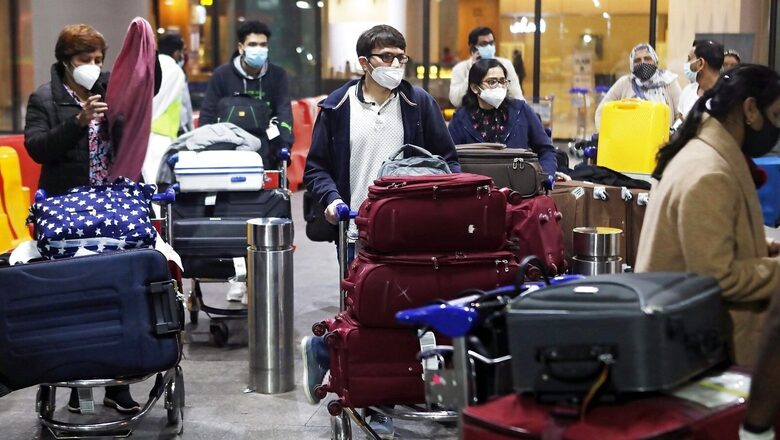
views
Since the first case of Omicron was reported in India just over a month ago, it has spread rapidly across the country, fuelling a surge of infections. On December 4, Maharashtra detected its first patient with new Covid variant B.1.1.529 or Omicron and in the last 26 days, the total number of Omicron cases has surged up to 450 in the state as of December 30.
As per the latest genome sequencing report, adding to worry, nearly one-third of the samples have been detected with Omicron in Mumbai. The sudden surge in the cases is indicating a possible community transmission and an emerging third wave of infections. Till December 28, Maharashtra reported 21.33% of India’s total count—the second-highest after Kerala (25.66%).
On Saturday, Mumbai reported 6,347 new COVID-19 cases, taking the caseload in the city to 7,91,457, a civic official said. Saturday’s count is the highest since the 5,888 cases witnessed on April 24 this year during the second wave. The death toll increased by one to reach 16,377. However, only 2,760 of 30,565 hospital beds in the city are occupied, as per the Brihanmumbai Municipal Corporation (BMC) data.
What are Omicron symptoms?
Omicron mainly causes mild symptoms which can be treated at home. Dr Hemlata Arora, senior consultant, infectious diseases, Nanavati Hospital told The Indian Express that the dominant Covid variant, Omicron, has different disease characteristics as compared to Alpha or Delta variants. International studies from South Africa or the United Kingdom indicate that the virus remains in the upper airways and doesn’t penetrate lung tissue or cause clotting disorders like its earlier variants—Delta or Alpha.
Omicron is causing a lot of upper respiratory symptoms such as cold and flu but not major lung complications, Arora added. However, the symptoms are mostly common in both variants, in Delta variants the severity is more with common symptoms like headache, runny nose, sneezing, sore throat and loss of smell. While in Omicron, most patients have fatigue along with joint pain, cold and headache.
How is Omicron different from the Delta variant?
Is Omicron different from Delta?
In November, with the Covid curve flattening, the total active Covid-19 cases in Maharashtra dropped to 7,555 on November 29. However, within a month the active cases in Maharashtra surged by 141% – 18,217, as recorded on December 30. However, scientists have attributed this spike to the Omicron variant.
The World Health Organisation (WHO) on November 26 declared it as a variant of concern due to its extreme level of contagiousness and ability to evade people’s immunity procured through the vaccination and past infection with Covid-19.
READ MORE | Covid Should Become Manageable Like Common Cold, Focus on Zero Deaths: Maha Task Force Member
Omicron Spread and Hospitalisation
According to the UK Health Security Agency (UKHSA), Omicron is displaying a growth advantage over the Delta variant in the UK. As stated by experts, Omicron also has a faster incubation period (gap of time between someone getting exposed to the virus and then showing symptoms) than Delta variant. This is also being reflected at the 24 hours daily doubling rate in Mumbai. On December 29, the city reported 2,445 daily Covid-19 cases which surged to 3,555 the next day.
Comparing the hospitalisation rate with the Delta variant, the need for supplemental oxygen therapy in Omicron is less. However, as stated by the Union Health Secretary Rajesh Bhushan the treatment protocols remain same for Omicron as that for Delta and Covid-19. Due to the low disease severity, doctors are considering a new antiviral drug by Merck—Molnupiravir – to treat infections in the early stages.
Are Vaccines working against Omicron?
In the last two weeks, 80% of the Omicron patients in Maharashtra are fully vaccinated. So the currently available vaccines may not be enough to stop the infection, but they do help in lessening the severity of the disease. “Omicron due to its multiple mutation in its spike protein has developed the ability to invade the immunity acquired through vaccination and previous infection. So, the cases of reinfection and breakthrough infection will surge in the third wave,” said Dr Shashank Joshi, member of the Covid-19 task force.
Globally, according to the latest data released by the UK Health Security Agency (UKHSA), two doses of the Oxford/AstraZeneca Covid jabs offer little protection against symptomatic infection, while 20 weeks after a second dose of the Pfizer/BioNTech or Moderna jabs, protection against Omicron is only about 10%. However, booster vaccinations have been found to ramp up this protection to about 65-75% two to four weeks after the jab, falling to about 40-50% protection from 10 or more weeks after the booster.
Data from the insurer Discovery Health and the South African Medical Research Council has suggested protection against severe complications after two jabs was about 70% for Omicron, compared with 90-95% for Delta.
Read all the Latest India News here




















Comments
0 comment